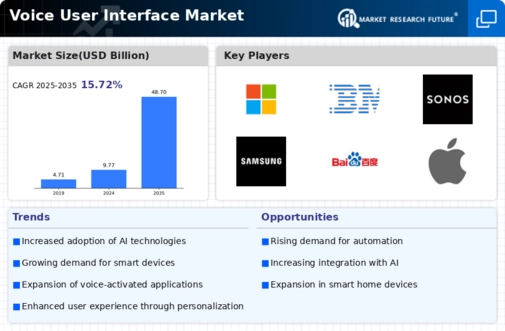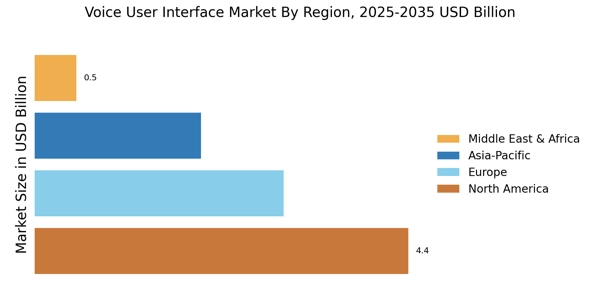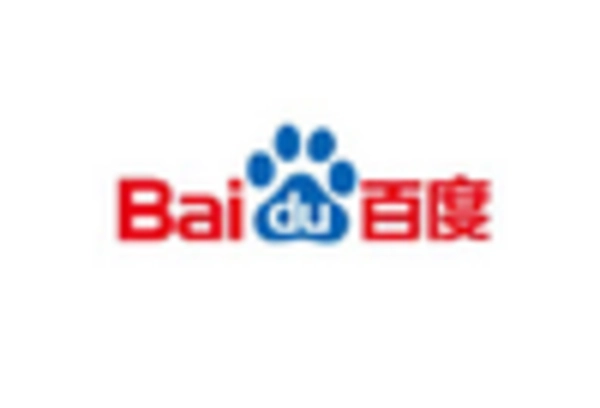Integration with IoT Devices
The integration of voice user interfaces with Internet of Things (IoT) devices is a pivotal driver for the Voice User Interface Market. As IoT technology continues to expand, the demand for seamless interaction between users and connected devices grows. By 2025, it is anticipated that there will be over 75 billion IoT devices in use, many of which will incorporate voice interfaces for enhanced user engagement. This integration allows users to control their smart homes, appliances, and other connected devices through simple voice commands, thereby improving convenience and accessibility. The synergy between voice technology and IoT is likely to create new opportunities for innovation within the Voice User Interface Market, as developers seek to create more intuitive and user-friendly experiences.
Growing Focus on Accessibility
The growing focus on accessibility is emerging as a crucial driver for the Voice User Interface Market. Organizations are increasingly recognizing the importance of making technology accessible to individuals with disabilities. Voice interfaces offer a practical solution, enabling users with visual impairments or mobility challenges to interact with devices more easily. As of 2025, it is estimated that over 1 billion people worldwide live with some form of disability, highlighting the need for inclusive technology. Companies are investing in voice technology to enhance accessibility features, thereby expanding their market reach and improving user satisfaction. This commitment to accessibility not only aligns with social responsibility but also positions businesses favorably within the Voice User Interface Market.
Advancements in Natural Language Processing
Advancements in natural language processing (NLP) are significantly influencing the Voice User Interface Market. As NLP technologies evolve, they enable more accurate and context-aware voice recognition, enhancing user interactions. The market for NLP is expected to grow substantially, with estimates suggesting a value of over 30 billion USD by 2026. This growth is indicative of the increasing reliance on voice interfaces in various applications, including customer service, healthcare, and education. Enhanced NLP capabilities allow for more nuanced understanding of user intent, which is crucial for improving user experience. Consequently, businesses are investing in NLP technologies to refine their voice interfaces, thereby driving the overall growth of the Voice User Interface Market.
Rising Demand for Voice-Activated Assistants
The Voice User Interface Market experiences a notable surge in demand for voice-activated assistants, driven by consumer preferences for hands-free technology. As of 2025, the market for voice-activated devices is projected to reach approximately 30 billion USD, reflecting a compound annual growth rate of around 20%. This trend is largely attributed to the increasing integration of voice technology in everyday devices, such as smartphones, smart speakers, and home automation systems. Consumers are increasingly seeking convenience and efficiency, which voice-activated assistants provide. Furthermore, the proliferation of smart home devices enhances the appeal of voice interfaces, as users can control multiple devices seamlessly through voice commands. This growing acceptance of voice technology suggests a robust future for the Voice User Interface Market.
Increased Investment in Voice Technology Startups
Increased investment in voice technology startups is significantly shaping the Voice User Interface Market. Venture capital funding for voice-related startups has surged, with investments reaching over 5 billion USD in 2025. This influx of capital is fostering innovation and accelerating the development of new voice applications and services. Investors are recognizing the potential of voice technology to transform various sectors, including retail, healthcare, and entertainment. As startups introduce novel solutions that leverage voice interfaces, the competitive landscape of the Voice User Interface Market is evolving. This trend suggests a vibrant ecosystem where new ideas and technologies can flourish, ultimately benefiting consumers and businesses alike.


















Leave a Comment